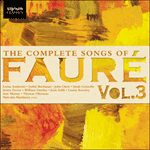Fauré wrote
Mirages at the age of seventy-four. His attention was drawn to these poems, in the year that they were published, by the husband of the work’s eventual dedicatee. He chose four of Brimont’s sixty texts that were published in a beautiful edition, worthy of an arty aristocrat, with woodcuts by Georges Barbier. The book’s cover has a small vignette in black and gold where a Cupid holds a circular mirror in which is reflected the mouth, neck and hair of a beautiful woman; Brimont’s tastes, like those of the Princesse de Polignac, were Sapphic – thus the ‘caresses de sœur’ in the cycle’s second song, and the naked eroticism of
Danseuse. The poems are preceded by frontispiece words that remind us that the First World War had only just ended: ‘Music [
Musiques] singing to the ear of the poet, visions from before the torment; dreams and nostalgia, reflections or mirages of that which persists despite everything, and which brings us calm in Nature’s eternity.’ After having composed his two great cycles to poems by Van Lerberghe, Fauré obviously felt at ease with this kind of symbolism – more accessible than, say, Mallarmé – which permitted him uneventful passion and event-filled calm. The poet was more or less unknown so he felt no compunction in making cuts to serve his purposes. One of these was to provide the young singer Madeleine Grey, one of his recent protégées, with a new work to perform – a reward for her fine advocacy of
La chanson d’Ève.
from notes by Graham Johnson © 2005
Fauré a écrit cettes mélodies à l'âge de soixante-quatorze ans. Son attention fut attirée vers ces poèmes, l’année même de leur publication, par le mari de celle à qui l’œuvre sera finalement dédiée. Il choisit quatre des soixante textes de Brimont, publiés dans une superbe édition, digne d’une aristocrate se voulant artiste, avec des gravures de Georges Barbier. En couverture, une petite vignette en noir et or montre un Cupidon tenant un miroir circulaire où se reflètent la bouche, le cou et la chevelure d’une femme splendide; les goûts de Brimont étaient, comme ceux de la princesse de Polignac, saphiques – d’où les «caresses de sœur» dans la deuxième mélodie du cycle, et l’érotisme nu de
Danseuse. Les poèmes sont précédés d’un texte en frontispice, qui nous rappelle que la Première Guerre mondiale vient tout juste de s’achever: «Musiques chantant à l’oreille du poète, visions d’avant la tourmente; rêves et nostalgie, reflets ou mirages de ce qui persiste envers et contre tout et nous apporte le calme dans l’éternité de la Nature.» Après avoir composé ses deux grands cycles sur des poèmes de Van Lerberghe, Fauré se sentit manifestement à l’aise avec ce genre de symbolisme – plus accessible, disons, que celui d’un Mallarmé – qui lui permettait une passion sereine, un calme débordant. L’auteur étant plus ou moins inconnu, Fauré n’eut aucun scrupule à tailler dans le texte quand le besoin s’en fit sentir. L’un de ces poèmes allait fournir à la jeune cantatrice Madeleine Grey (l’une des récentes protégées de Fauré) une nouvelle œuvre à interpréter – en remerciement de son soutien appuyé à
La chanson d’Ève.
extrait des notes rédigées par Graham Johnson © 2005
Français: Hypérion


 Fauré: The Complete Songs, Vol. 3
Fauré: The Complete Songs, Vol. 3
